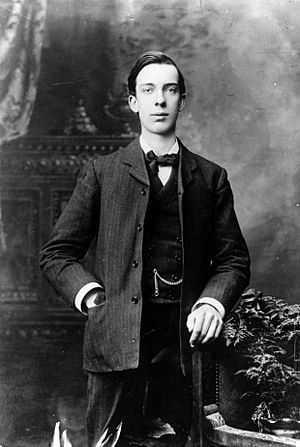Willie Pearse facts for kids
Quick facts for kids
William Pearse
|
|
|---|---|
 |
|
| Born | 15 November 1881 Dublin City, Ireland |
| Died | 4 May 1916 (aged 34) Kilmainham Gaol, Dublin, Ireland |
| Allegiance | Irish Volunteers |
| Years of service | 1913–1916 |
William James Pearse (also known as Uilliam Seamus Mac Piarais in Irish) was born on November 15, 1881. He was an Irish republican who was executed for his part in the Easter Rising. He was the younger brother of Patrick Pearse, who was a main leader of the rising.
Early Life and Art
Willie Pearse was born in Dublin, Ireland. He was very close to his older brother, Patrick, and often helped him with his projects.
Willie had a talent for art, just like his father. He became a sculptor, which means he created art by shaping materials like stone or clay. He studied art in Dublin and Paris. He also attended the Kensington School of Art in London, where some of his artworks gained attention. You can find some of his sculptures in churches in Limerick, Letterkenny, and Dublin.
Willie was trained to take over his father's stonemason business, which involved cutting and shaping stone. However, he decided to help Patrick run St. Enda's School, which Patrick started in 1908. Willie was very involved in the school's art and theater programs and helped with its daily operations.
Role in the Easter Rising
Willie Pearse joined his brother in the Irish Volunteers, a group that wanted Ireland to be an independent country. He also became part of the Republican movement, which aimed for an Irish republic.
In 1916, Willie took part in the Easter Rising, a rebellion against British rule in Ireland. He stayed by his brother's side at the General Post Office in Dublin, which was a key location during the rising.
After the rebellion ended, Willie surrendered. He was then court-martialled, meaning he was tried by a military court. He was sentenced to death. Some people believe he was condemned because of his famous last name, but he strongly stated his involvement during his trial.
On May 3, Willie was allowed to visit his brother Patrick in Kilmainham Gaol, a prison, to say goodbye. However, Patrick was executed before Willie arrived. Willie Pearse was executed the next day, on May 4, 1916. He and Patrick were the only two brothers to be executed after the Easter Rising.
Remembering William Pearse
While many places are named after Patrick Pearse, Willie is also remembered. In 1966, the Westland Row railway station in Dublin was renamed Pearse Station to honor both brothers. Pearse Square and Pearse Street in Dublin were also renamed for them. Pearse Street was actually their birthplace.
Many other streets and roads in Ireland are named Pearse. There is also a Pearse Brothers Park in Rathfarnham. A bridge over the Dodder river on the Rathfarnham Road is named after them, with a plaque showing their profiles.
The Brothers Pearse Athletic Club, started in Rathfarnham, is named after Willie and Patrick.
Several Gaelic Athletic Association (GAA) clubs and playing fields are named after both Pearse brothers, and at least one is named specifically after Willie:
- Armagh: Annaghmore Pearses GAC; Pearse Óg GAC and its grounds, Pearse Óg Park, Armagh
- Cork: CLG Na Piarsaigh, Cork
- Dublin: Willie Pearse Park, the grounds of Crumlin GAA
- Kerry: Dromid Pearses GAC; Kilflynn Pearses HC (a club that no longer exists)
- Limerick: CLG Na Piarsaigh, Limerick
- Louth: CPG Na Piarsaigh, Dundalk
- Monaghan: Ballybay Pearse Brothers, and its grounds, Pearse Park
- Tyrone: Dregish Pearse Og GAC; Fintona Pearses GAC; and Galbally Pearses GAC
- Wicklow: Pearses' Park, Arklow
- London: Brother Pearse's GAC, London
- Yorkshire: Brothers Pearse GAC, Huddersfield

